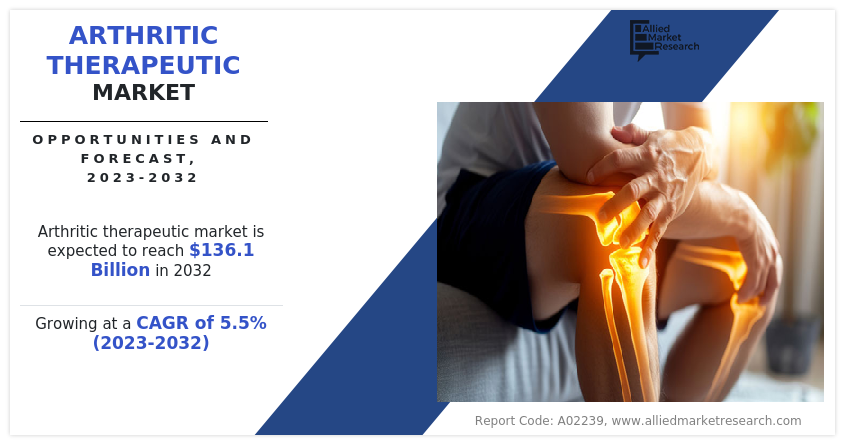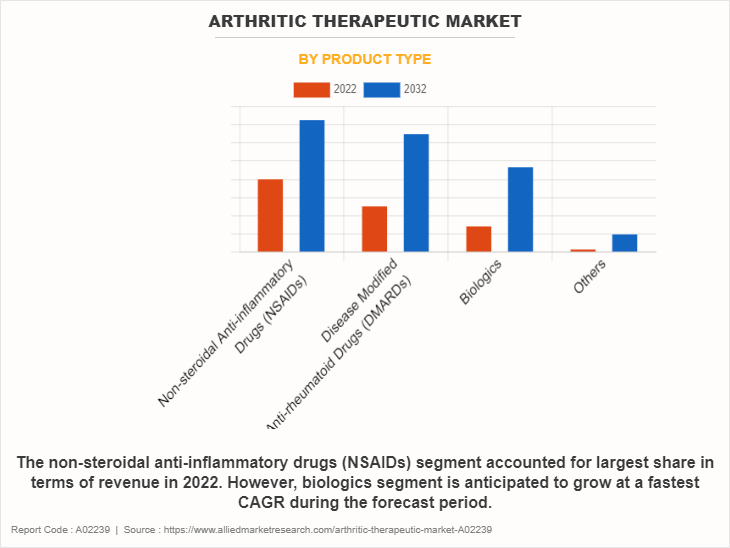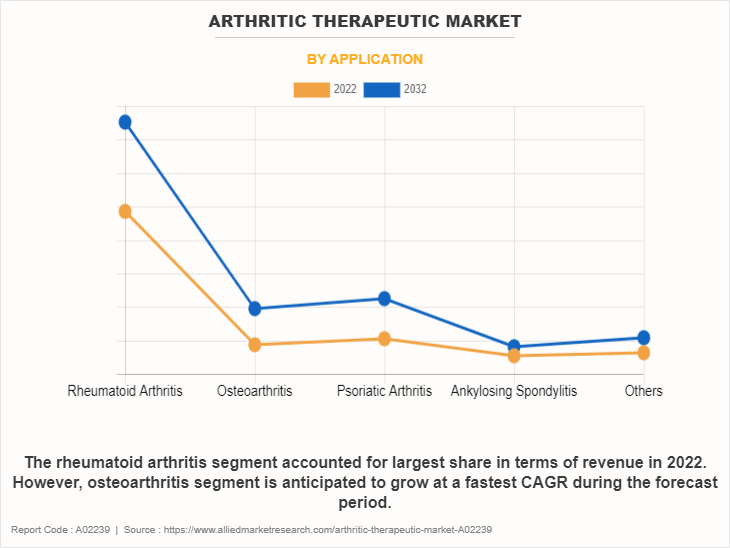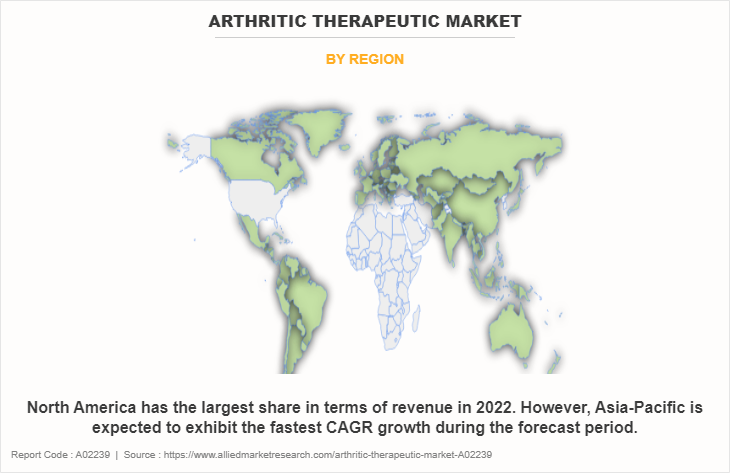Arthritic Therapeutic Market Research, 2032
The global arthritic therapeutic market was valued at $79.5 billion in 2022, and is projected to reach $136.1 billion by 2032, growing at a CAGR of 5.5% from 2023 to 2032.The growing geriatric population acts as a major factor for driving the growth of arthritic therapeutic market. The World Health Organization (WHO) projects a substantial increase in the global elderly population, with an estimated 1.4 billion people aged 60 years and over by 2030. This demographic shift underscores the escalating prevalence of arthritis. Responding to this surge, the pharmaceutical industry channels its efforts into developing a diverse array of therapeutic solutions, including medications, biologics, and innovative treatments.

The term "arthritic therapeutics" describes a group of medical procedures intended to treat and manage different types of arthritis, including rheumatoid arthritis and osteoarthritis and others. NSAIDs, biologics, and cutting-edge therapies are some of the treatments available to improve the overall quality of life for those with the condition by lowering pain, inflammation, and enhancing joint function.
Key Takeaways
- On the basis of type, the biologics segment dominated the arthritic therapeutic market size in terms of revenue in 2022 and is anticipated to grow at the fastest CAGR during the forecast period.
- On the basis of application, the rheumatoid arthritis segment dominated the arthritic therapeutic market size in terms of revenue in 2022. However, the osteoarthritis segment is anticipated to grow at the fastest CAGR during the forecast period.
- Region wise, North America generated the largest revenue in 2022. However, Asia-Pacific is anticipated to grow at the highest CAGR during the forecast period.
- Country wise, U.S. generated the largest revenue in 2022. However, Mexico is anticipated to grow at the highest CAGR during the forecast period.
Market Dynamics
The growing prevalence of arthritis conditions is a key driver for the growth of the arthritic therapeutic industry. According to the Centers for Disease Control and Prevention (CDC), approximately 53.2 million people in the U.S. alone have doctor diagnosed arthritis. This condition is more prevalent among women, with 20.9% affected compared to 16.3% of men. In addition, the aging population, coupled with lifestyle factors such as obesity and sedentary habits, contributes to the increasing incidence of arthritis globally. Arthritis, characterized by joint inflammation and pain, significantly impacts individuals quality of life, and demands effective therapeutic interventions. As the number of diagnosed cases rises, there is a growing demand for diverse therapeutics, including NSAIDs, biologics, and lifestyle modifications, to alleviate symptoms and improve joint function. Consequently, the arthritic therapeutic market experiences continuous expansion to meet the healthcare needs of an ever-growing population affected by this chronic arthritic conditions.
Furthermore, the worldwide focus on upgrading healthcare infrastructure is a crucial driver of arthritic therapeutic market growth. Improved healthcare infrastructure allows for easier diagnosis, treatment, and management of arthritic problems. The initiative involves the establishment of experts clinics, diagnostic facilities, and enhanced availability of arthritic therapies. In addition, better infrastructure not only enables prompt and precise illness detection, but also simplifies the administration of innovative and tailored medicines which supports the market growth. As healthcare systems improve, patients benefit from more efficient and comprehensive arthritis care, which fuels market growth. This initiative is consistent with the larger objective of treating the rising prevalence of arthritis and improving overall public health outcomes.
Moreover, the arthritic therapeutic market is expanding rapidly, owing to greater focus on biosimilar research and development. Biosimilars are bioequivalent variants of established biologic medications that provide affordable alternatives. The dedication of major pharmaceutical corporations to biosimilar research meets the growing need for less expensive arthritis therapies. This strategy move enables significant firms to diversify their product portfolios and provide competitive choices while retaining therapeutic effectiveness. Biosimilars also contribute to increasing market competition, which might reduce total treatment costs and improve accessibility. The emphasis on biosimilar innovation is consistent with the wider industry trend of customized treatment and cost-effective healthcare solutions. As important companies engage in biosimilar R&D, the arthritic therapeutic industry is positioned for further development, benefiting both patients and overall helathcare which drive the market growth.
However, the factors that hinder the arthritic therapeutic market are the availability of alternative and complementary therapies, as well as the challenge of insufficient diagnosis. Acupuncture, herbal medicines, dietary interventions, and other non-conventional methods are chosen by some people instead of traditional medical treatments. Thus, impacting the market growth. Additionally, lack of knowledge and a poor diagnosis delay the initiation of treatment, limiting the market's growth. To overcome these challenges along with offering timely access to suitable medical treatments, increased awareness about the symptoms of arthritis along with improved diagnostic skills is essential, in driving the expansion of the arthritic therapeutic market.
The recession can have moderate impacts on the arthritic therapeutic market. On the downside, economic downturns lead to reduced healthcare spending and affordability challenges for patients, affecting the adoption of arthritic therapies. Thus, limiting the access to expensive biologics and advanced treatments have become more restricted. In addition, the rise in regulatory approvals for arthritis therapeutics, including biosimilars, is further contributing to the sustainability of market growth by ensuring a competitive landscape, rising innovation, and providing patients with more affordable treatment options, thereby reducing the negative impacts of a recession.
Segments Overview
The arthritic therapeutic market is segmented on the basis of type, application, and region. On the basis of type, the market is segmented into non-steroidal anti-inflammatory drugs (NSAIDs), disease modified anti-rheumatoid drugs (DMARDs), biologics and others. On the basis of application, the market is segmented into rheumatoid arthritis, osteoarthritis, psoriatic arthritis, ankylosing spondylitis, and others. Region-wise, the market is analyzed across North America (U.S., Canada, and Mexico), Europe (Germany, France, UK, Italy, Spain, and rest of Europe), Asia-Pacific (China, Japan, India, Australia, South Korea, and rest of Asia-Pacific), and LA (Brazil, Colombia, Argentina, and rest of LA) and MEA (GCC, South Africa, North Africa and rest of MEA).
By Product Type
Depending on product type, the market is segmented into non-steroidal anti-inflammatory drugs (NSAIDs), disease modified anti-rheumatoid drugs (DMARDs), biologics and others. The non-steroidal Anti-inflammatory Drugs (NSAIDs) segment accounted for the largest arthritic therapeutic market share in terms of revenue in 2022 and is expected to maintain its lead during the forecast period. This is attributed to their widespread use for pain relief and anti-inflammatory effects, making them a preferred choice, driving substantial revenue in the pharmaceutical market. However, the biologics segment is expected to exhibit the fastest CAGR growth during the forecast period. This is primarily attributed to the targeted mechanism of action, which specifically addresses inflammatory pathways, resulting in effective symptom management and disease modification. Biologics' precision in targeting key molecules involved in arthritis pathogenesis, coupled with ongoing advancements in biotechnology and personalized medicine, contribute to their sustained prominence and anticipated growth in the market.

By Application
Depending on application, the market is segmented into rheumatoid arthritis, osteoarthritis, psoriatic arthritis, ankylosing spondylitis, and others. The rheumatoid arthritis segment accounted for the largest arthritic therapeutic market share in terms of revenue in 2022 and is expected to maintain its lead during the forecast period owing to the escalating global prevalence of rheumatoid arthritis. The heightened demand for precise and innovative treatments in response to this prevalence further strengthens the segment's position. In addition, ongoing R&D initiatives, particularly directed at pioneering therapies such as biologics and disease-modifying drugs customized for rheumatoid arthritis, play a pivotal role in sustaining the prominence of this segment within the broader arthritis therapeutics market.
However, the osteoarthritis segment is expected to exhibit the fastest CAGR growth during the arthritic therapeutic market forecast period. This is driven by several factors, including the rise in geriatric population, increased prevalence of obesity, and a growing awareness of early osteoarthritis diagnosis and treatment. In addition, the growing initiatives in research and advancements in understanding the molecular mechanisms of osteoarthritis and the development of targeted interventions, along with a focus on improving pain management strategies, potentially contribute to the segment growth.

By Region
Region wise, the arthritic therapeutic market is analyzed across North America, Europe, Asia-Pacific, and LAMEA. North America had the largest share in terms of revenue in 2022 and is expected to maintain its lead during the forecast period owing to a well-established healthcare infrastructure and advanced medical facilities. The region's robust economy enables significant investments in healthcare research, development, and technology. Further, a high awareness level regarding availability of therapeutics for arthritis and high adoption contributes to the dominance of North America in the arthritis therapeutics market.
However, Asia-Pacific is expected to exhibit the fastest growth during the forecast period, owing to several key factors. The region's robust economic development, coupled with a rapidly expanding aging population, is contributing to an increased prevalence of arthritis. Rising healthcare awareness and improving healthcare infrastructure in countries across Asia-Pacific are fostering greater access to arthritis therapeutics.

Competitive Analysis
Major players such as AbbVie Inc, and Pfizer have adopted product launch, acquisition, product development and product approval as key developmental strategies to improve the product portfolio of the arthritic therapeutic market. For instance, in December 2021, Amgen Inc, announced that the U.S. Food and Drug Administration (FDA) has approved Otezla (apremilast) for the treatment of adult patients with plaque psoriasis who are candidates for phototherapy or systemic therapy. With this expanded indication, Otezla is now the first and only oral treatment approved in adult patients with plaque psoriasis across all severities, including mild, moderate and severe.
Recent Developments in Arthritic Therapeutic Industry
- In October 2023, Novartis, a global leader in immuno-dermatology and rheumatology, announced that the U.S. Food and Drug Administration (FDA) has approved an intravenous (IV) formulation of Cosentyx (secukinumab) for the treatment of adults with psoriatic arthritis (PsA), ankylosing spondylitis (AS) and non-radiographic axial spondyloarthritis (nr-axSpA). Cosentyx is the only treatment approved in an IV formulation that specifically targets and blocks interleukin-17A (IL-17A), and the only non-tumor necrosis factor alpha (TNF-α) IV option available in all these indications.
- In Jan 2022, AbbVie announced that the U.S. Food and Drug Administration (FDA) has approved SKYRIZI (risankizumab-rzaa) for the treatment of adults with active psoriatic arthritis (PsA), a systemic inflammatory disease that affects the skin and joints and impacts approximately 30 percent of patients with psoriasis.
- In July 2020, The Janssen Pharmaceutical Companies of Johnson & Johnson announced that the U.S. Food and Drug Administration (FDA) has approved TREMFYA (guselkumab) for adult patients with active psoriatic arthritis (PsA), a chronic progressive disease characterized by painful joints and skin inflammation.
Key Benefits for Stakeholders
- This report provides a quantitative analysis of the market segments, current trends, estimations, and dynamics of the arthritic therapeutic market analysis from 2022 to 2032 to identify the prevailing arthritic therapeutic market opportunity.
- The market research is offered along with information related to key drivers, restraints, and opportunities.
- Porter's five forces analysis highlights the potency of buyers and suppliers to enable stakeholders make profit-oriented business decisions and strengthen their supplier-buyer network.
- In-depth analysis of the arthritic therapeutic market segmentation assists to determine the prevailing market opportunities.
- Major countries in each region are mapped according to their revenue contribution to the global market.
- Market player positioning facilitates benchmarking and provides a clear understanding of the present position of the market players.
- The report includes the analysis of the regional as well as global arthritic therapeutic market trends, key players, market segments, application areas, and market growth strategies.
Arthritic Therapeutic Market Report Highlights
| Aspects | Details |
| Forecast period | 2022 - 2032 |
| Report Pages | 250 |
| By Product Type |
|
| By Application |
|
| By Region |
|
| Key Market Players | LEO Pharma, Viatris Inc., Amgen Inc., AbbVie Inc., Merck & Co., Inc., Pfizer Inc., Jhonson & Jhonson, Novartis AG, Bausch Health (Storz Opthalmic Instrument), Celltrion Inc |
Analyst Review
The arthritic therapeutic market highlights sustained growth driven by an aging population, increased arthritis prevalence, and advanced therapeutic innovations. Biotechnological advancements, including targeted biologics and JAK inhibitors, play a pivotal role.
In addition, rising awareness, early diagnosis, and shifting healthcare landscape toward patient-centric approaches is further anticipated to drive the market growth. Furthermore, government initiatives, supportive regulatory frameworks, and improving healthcare infrastructure contribute to the market's positive trajectory. With a strong emphasis on personalized medicine and an increasing focus on lifestyle-related risk factors, the arthritic therapeutic market is positioned for sustained growth.
Furthermore, North America is expected to remain dominant during the forecast period, due to a surge in the use of arthritis therapeutics. This is attributed to a well-established healthcare infrastructure and high healthcare expenditure. Furthermore, the presence of major market players fosters innovation and product development. In addition, Asia-Pacific and LAMEA are expected to offer lucrative opportunities to the key players, due to surge in awareness toward preventative healthcare
The total market value of arthritic therapeutic market is $79,515.56 million in 2022.
The forecast period for arthritic therapeutic market is 2023 to 2032
The market value of arthritic therapeutic market in 2032 is $136,093.38 million
The base year is 2022 in arthritic therapeutic market .
Top companies such as AbbVie Inc., Pfizer, Amgen Inc, Bristol-Myers Squibb, Eli Lilly and Company, F. Hoffmann-La Roche Ltd held a high market position in 202
2. These key players held a high market postion owing to the strong geographical foothold in North America, Europe, Asia-Pacific, LA and MEA.
The non-steroidal Anti-inflammatory Drugs (NSAIDs) segment is the most influencing segment in arthritic therapeutic market owing to their widespread use for pain relief and anti-inflammatory effects, making them a preferred choice, driving substantial revenue in the pharmaceutical market.
The major factor that fuels the growth of the arthritic therapeutic market are technological advancements, rising incidence of arthritic disorders and conditions and growing aging population drive the growth of the global arthritic therapeutic market.
Arthritis therapeutics involves medical interventions to alleviate symptoms, reduce inflammation, and enhance joint mobility. It incorporates pharmaceuticals, biologics, and lifestyle modifications tailored to specific arthritis types, aiming to improve overall joint health, mitigate pain, and slow disease progression for enhanced patient well-being.
Loading Table Of Content...
Loading Research Methodology...



